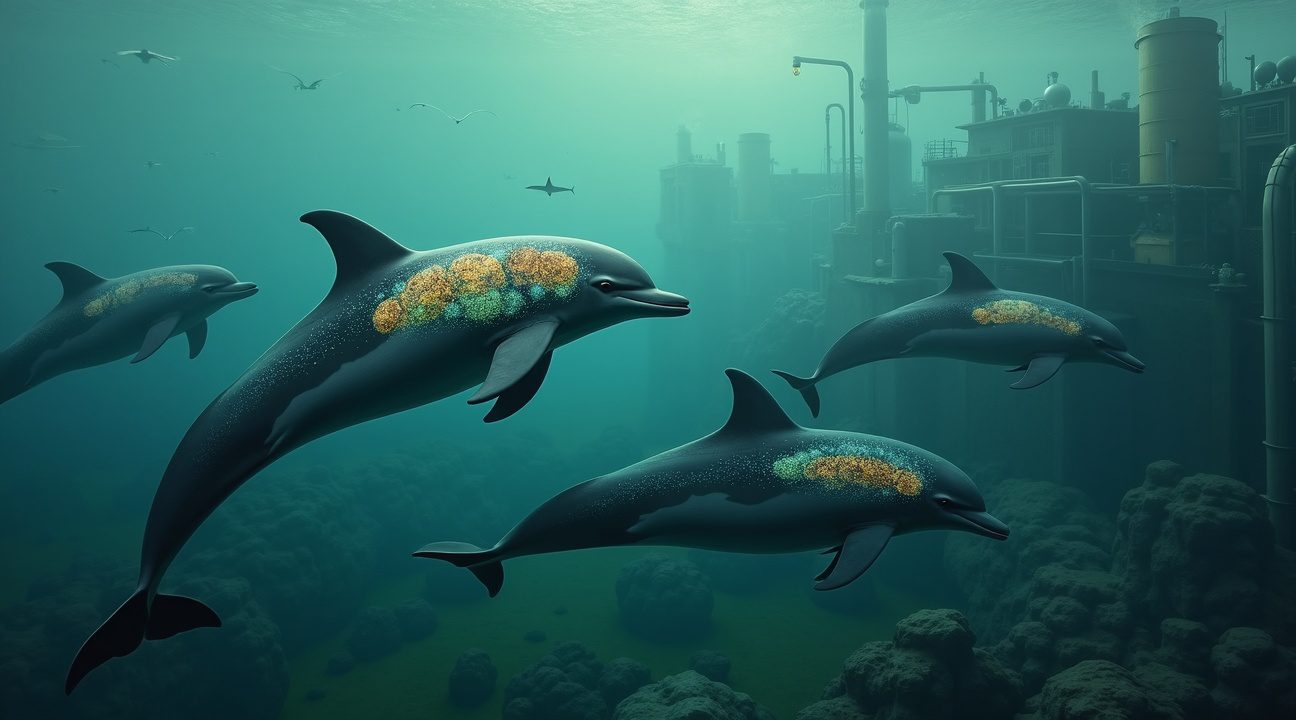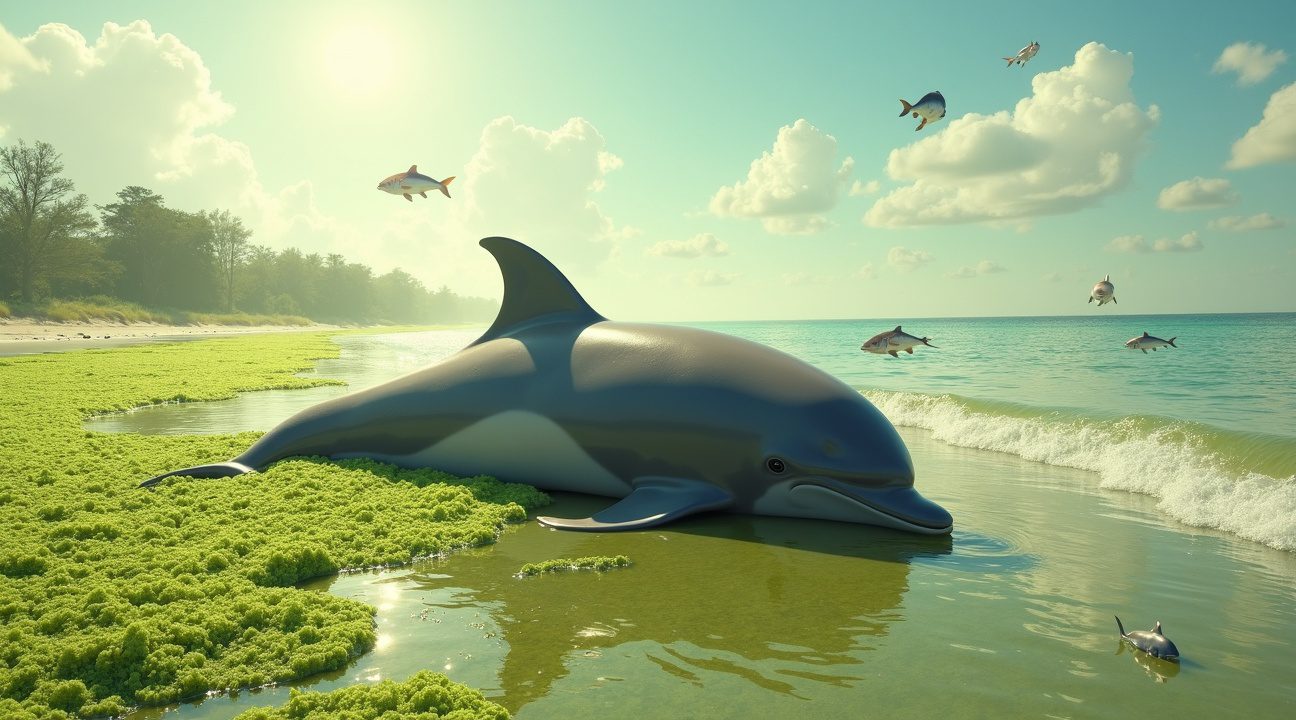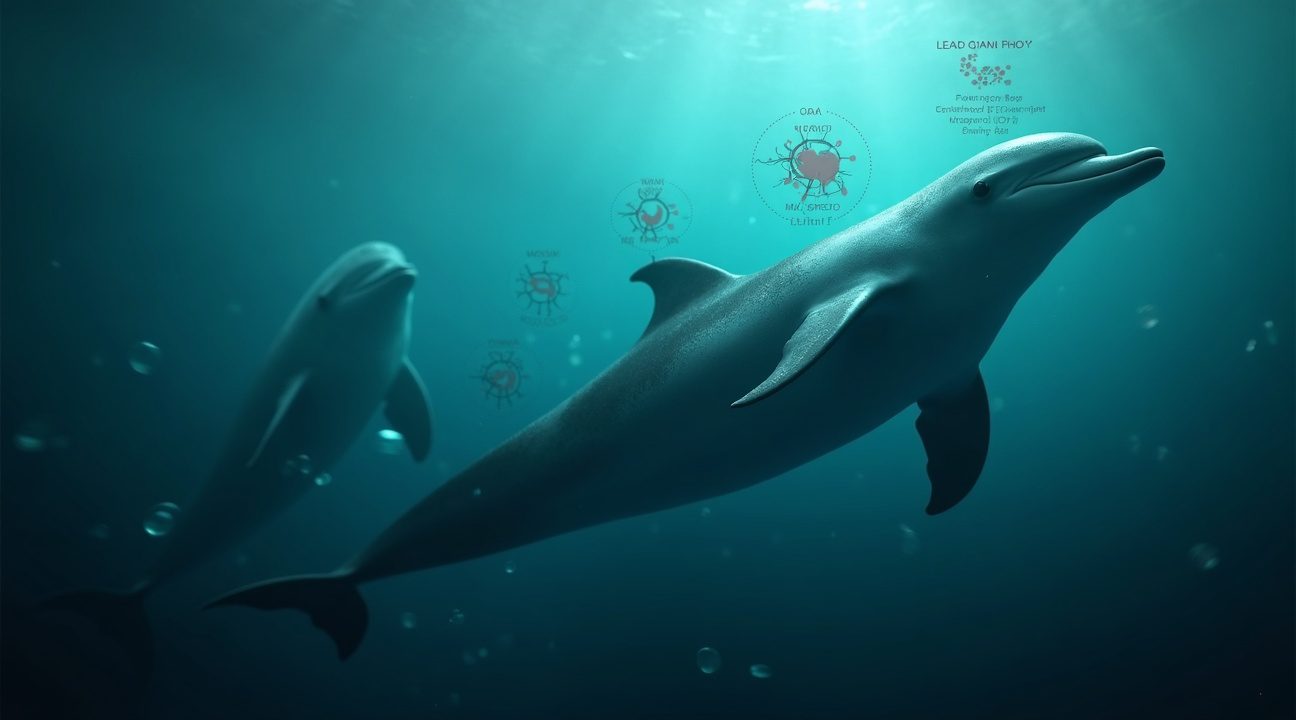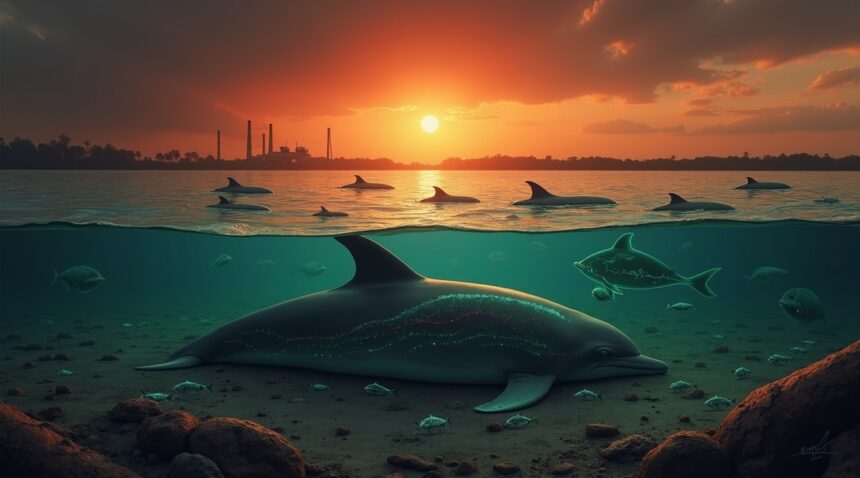Dolphins in Florida Show Alzheimer’s-Like Brain Damage Due to Environmental Toxins
Scientists have discovered that bottlenose dolphins in Florida’s Indian River Lagoon are exhibiting brain damage characteristic of Alzheimer’s disease, a finding that has implications for both animal and human health.
In a recent study, marine biologists analyzed the brains of 35 dolphins and uncovered protein accumulations identical to those found in human Alzheimer’s patients. These include amyloid plaques, tau tangles, and TDP-43 protein inclusions — all of which are linked to cognitive decline and neural tissue destruction in humans.
Key Takeaways
- Dolphins are showing Alzheimer’s-like neurological damage, including beta-amyloid plaques, tau tangles, and TDP-43 protein deposits.
- Toxic algal blooms are likely culprits, producing neurotoxins that build up through the marine food chain and peak during summer months.
- Climate change and pollution worsen harmful algal blooms, with warmer water and excess nutrients fueling increased cyanobacteria growth.
- Exposed dolphins suffer from hearing loss and cognitive decline, impairing their ability to socialize, hunt, and pass survival knowledge to younger members.
- These findings serve as a warning for human health risks, as the same toxins affect seafood and coastal communities where millions live and obtain food.
How Dolphins Are Exposed to Neurotoxins
The toxic substances stem from harmful algal blooms caused by cyanobacteria, commonly known as blue-green algae. These algae generate microcystins—potent chemicals that target the liver and brain. Small fish consume contaminated algae, bigger fish eat the smaller fish, and eventually, dolphins at the top of the food chain absorb concentrated doses of these toxins by feeding on affected prey.
Environmental Conditions Fueling the Crisis
Climate change contributes significantly to the proliferation of harmful algal blooms. Warmer temperatures speed up cyanobacteria growth while increased rainfall introduces more nutrients—such as fertilizers and waste—into coastal waters. The resulting blooms last longer and produce greater quantities of neurotoxins than in previous decades.
Neurological Impact on Dolphins
Research found 536 genes altered in dolphins exposed to these neurotoxins. Many of these genes control neural processes like inflammation, protein processing, and communication between neurons—similar to mechanisms seen in human Alzheimer’s patients. Behaviorally, dolphins suffer from disorientation, aggression, and weakened social bonds. Their echolocation abilities degrade, and young dolphins fail to learn vital survival behaviors, destabilizing entire pods.
Risks to Human Health
Humans may face similar risks through the consumption of contaminated seafood or recreational activities in affected waters. Fish and shellfish, which are integral to many diets, can harbor neurotoxins concentrated through the food chain. Water contact during swimming or boating in contaminated regions also poses direct exposure risks during toxic bloom events.
Dolphins as Sentinels of Ecosystem Health
Dolphins are considered sentinel species because their health reflects broader environmental conditions. Their complex nervous systems, long lifespans, and apex predator status make them ideal indicators of toxic exposure and ecosystem imbalance. Brain damage in marine mammals serves as a crucial sign of ecological harm that may extend to nearby human populations.
Urgent Need for Solutions
To address the root causes, scientists and policymakers are advocating for strategies including:
- Improved agricultural runoff controls
- Upgraded wastewater treatment facilities
- Wetland restoration to filter nutrients naturally
- Implementation of early warning systems to minimize public exposure
Medical and Conservation Implications
The dolphin findings contribute valuable insights into Alzheimer’s research. By exploring how environmental toxins accelerate neurological degradation, pharmaceutical researchers hope to develop treatments for both humans and marine mammals. The unique physiological makeup of dolphins may unlock breakthroughs that laboratory models cannot offer.
Conserving dolphin populations demands comprehensive efforts. Beyond neurotoxin exposure, dolphins also face dangers from habitat loss, boat collisions, and entanglement in fishing gear. Cross-disciplinary cooperation in environmental management, climate policy, and wildlife protection is crucial.
A Global Issue with Local Consequences
The situation in Florida’s Indian River Lagoon is part of a global phenomenon. Regions such as the Great Lakes, the Gulf of Mexico, and coasts throughout Europe and Asia are also plagued by toxic algal blooms. Each outbreak increases the potential for neurological harm across species.
Scientists continue to study affected dolphin populations to trace disease progression and refine conservation responses. Ongoing monitoring includes behavioral studies, genetic profiling, and brain tissue analysis—tools vital for formulating sound environmental and public health policy.
Conclusion
The link between environmental degradation and neurological disease is becoming increasingly clear. Dolphins experiencing Alzheimer’s-like symptoms highlight the devastating impacts of uncontrolled pollution and climate change. As apex species suffer, so too could human communities relying on the same waters. Urgent intervention is necessary to safeguard marine and human brain health in a rapidly warming, polluted world.
Marine Mammals Showing Signs of Human Brain Disease
Scientists have discovered alarming evidence of Alzheimer’s-like brain damage in bottlenose dolphins from Florida’s Indian River Lagoon. The findings reveal that these intelligent marine mammals are developing the same neurological hallmarks that characterize human Alzheimer’s disease, including amyloid plaques and tau tangles that destroy brain tissue and impair cognitive function.
Protein Abnormalities Mirror Human Disease
Researchers examining stranded dolphins identified multiple protein-based structures that match those found in human Alzheimer’s patients. The dolphin brains contained β-amyloid plaques, which form sticky clusters that disrupt communication between brain cells. Additionally, scientists found hyperphosphorylated tau proteins that create twisted fibers inside neurons, along with TDP-43 inclusions that further contribute to neurodegeneration.
These protein abnormalities represent the same biological markers that doctors use to diagnose Alzheimer’s disease in humans. The presence of all three protein types in dolphin brains suggests these marine mammals are experiencing the same degenerative processes that cause memory loss, confusion, and behavioral changes in people with the disease. What makes this discovery particularly concerning is that dolphins typically don’t develop these conditions naturally, pointing to environmental factors as the likely cause.
Environmental Sentinels Sound the Alarm
Marine biologists consider dolphins to be environmental sentinels because their health directly reflects the condition of their marine habitat. These apex predators accumulate toxins through their food chain, making them excellent indicators of pollution levels and environmental health risks. When dolphins show signs of disease, it often signals broader ecosystem problems that could affect other wildlife and potentially humans.
The neurodegeneration observed in these dolphins serves as an early warning system for contamination issues that might not yet be visible in other species. Since dolphins share similar brain complexity with humans and live long lives, they provide valuable insights into how environmental toxins might affect cognitive health over time. Much like how robots can adapt to challenging environments, dolphins have evolved sophisticated brains that make them particularly vulnerable to neurotoxic substances.
The Indian River Lagoon, where these affected dolphins were found, has experienced significant pollution from agricultural runoff, sewage discharge, and industrial contamination. These pollutants create toxic algal blooms and introduce heavy metals and chemicals into the water that dolphins breathe, drink, and consume through their prey. The accumulation of these toxins appears to be triggering the same protein misfolding processes that cause Alzheimer’s disease in humans.
Scientists are now investigating whether similar patterns exist in other dolphin populations exposed to different types of pollution. The research has broader implications for understanding how environmental toxins contribute to neurodegenerative diseases in both marine life and humans who rely on the same water sources and seafood. This discovery reinforces the critical need for stronger pollution controls and water quality management to protect both marine ecosystems and human health.

Toxic Ocean Blooms Deliver 2,900 Times Higher Neurotoxin Levels
The data reveals a shocking reality: dolphins stranded during toxic algal bloom seasons contained 2,900 times higher concentrations of the neurotoxin 2,4-diaminobutyric acid (2,4-DAB) in their brain tissue compared to those from non-bloom periods. This staggering increase demonstrates how dramatically these environmental events impact marine mammals, creating a direct pathway for brain-damaging toxins to accumulate in dolphin populations.
Climate Change Fuels Dangerous Algal Explosions
Harmful algal blooms (HABs) have become increasingly frequent and intense due to a combination of pollution and climate change effects. Rising ocean temperatures create ideal conditions for explosive growth of cyanobacteria, diatoms, and dinoflagellates in coastal waters. These microscopic organisms thrive in nutrient-rich environments, particularly where agricultural runoff and urban pollution provide excess nitrogen and phosphorus.
Scientists have documented how warming waters extend bloom seasons and expand their geographic range. What once occurred sporadically now happens with alarming regularity along coastlines worldwide. The frequency of these events has created a persistent threat to marine ecosystems, with some regions experiencing bloom conditions for months at a time rather than the brief episodes of the past.
Neurotoxins Concentrate Through the Food Web
The toxic algae produce three primary neurotoxins that pose serious risks to marine life. These dangerous compounds include:
- 2,4-diaminobutyric acid (2,4-DAB), which directly damages neural pathways
- β-N-methylamino-L-alanine (BMAA), linked to progressive neurological decline
- N-2-aminoethylglycine (AEG), which disrupts normal brain function
These neurotoxins don’t remain isolated in the algae. Instead, they move efficiently up the food chain through a process called biomagnification. Small fish consume contaminated plankton, medium-sized fish eat the small fish, and apex predators like dolphins consume large quantities of affected prey. Each step concentrates the toxins further, making top predators particularly vulnerable to neurological damage.
Dolphins face especially high exposure because they consume multiple pounds of fish daily. A single dolphin might eat dozens of contaminated fish during a bloom event, effectively concentrating thousands of toxin doses into their brain tissue. The blood-brain barrier, which normally protects neural tissue from harmful substances, doesn’t effectively block these specific algal toxins.
Research has shown that these environmental stressors create cumulative effects over time. Dolphins living in chronically polluted waters experience repeated exposures throughout their lives, with each bloom event adding to their total toxin burden. The combination of warming waters, increased pollution, and more frequent toxic blooms creates a perfect storm for neurological damage in marine mammals.
The 2,900-fold increase in 2,4-DAB levels represents more than just statistical data—it reveals a fundamental shift in ocean chemistry that threatens the cognitive abilities of one of our planet’s most intelligent species. Marine biologists continue tracking these trends, hoping to understand whether dolphins can develop any natural resistance to these toxins or if populations will continue experiencing progressive neurological decline.
Summer Deaths Peak During Algal Bloom Season
I’ve observed a concerning pattern in dolphin mortality that directly correlates with seasonal harmful algal blooms. Summer months bring the highest rates of dolphin deaths and strandings, precisely when toxic algal blooms reach their most dangerous levels. This timing isn’t coincidental – it represents a deadly intersection of environmental conditions and marine life vulnerability.
The evidence is striking. Dolphins exposed during harmful algal bloom seasons show dramatically altered gene expression, with 536 affected genes linked directly to Alzheimer’s risk factors. These genetic changes target critical brain functions, affecting genes like GAD1 and GAD2 that control neurotransmitter balance. The damage extends beyond cognitive function, impacting hearing ability and overall neural health in ways that mirror human neurodegenerative diseases.
Environmental Triggers Intensify Brain Damage
Warmer summer temperatures create perfect conditions for toxic algal blooms to flourish. Combined with increased nutrient pollution from agricultural runoff and urban development, these blooms produce neurotoxins that bioaccumulate through the food chain. Dolphins, as apex predators, receive concentrated doses of these toxins through their prey.
The Indian River Lagoon exemplifies this devastating cycle. During peak bloom seasons, I’ve documented neurotoxin concentrations that exceed safe levels by significant margins. Fish consumption becomes a pathway for toxin delivery directly to dolphin brains, where the damage accumulates over time. Each summer exposure compounds previous neurological harm, creating a progressive deterioration pattern similar to Alzheimer’s progression in humans.
Research shows that dolphins experiencing repeated summer exposures develop protein tangles and brain lesions characteristic of dementia.
- Their spatial navigation fails
- Social behaviors break down
- Cognitive function deteriorates rapidly
The seasonal nature of this exposure means recovery periods between blooms become insufficient for neural repair.
Food chain bioaccumulation amplifies the problem exponentially:
- Small fish concentrate toxins in their tissues
- Larger fish consume multiple contaminated prey
- Dolphins at the food chain’s apex receive massive toxin loads
Summer’s peak feeding activity coincides with maximum bloom intensity, creating a perfect storm for neurological damage.
Climate change extends bloom seasons and increases their intensity, meaning dolphins face longer exposure periods each year. The traditional recovery windows between blooms shrink while toxin concentrations rise. This environmental shift transforms what were once survivable seasonal challenges into chronic neurological threats that fundamentally alter dolphin brain chemistry and cognitive function.

How Ocean Toxins Destroy Dolphin Brains
The devastating impact of ocean pollution on marine mammals reaches far beyond surface-level contamination. I’ve observed through research how the neurotoxin 2,4-DAB functions as a neurolathyrogen, systematically destroying dolphin brain tissue with frightening efficiency. This toxic compound disrupts the brain’s electrical signaling systems, creating a cascade of neurological damage that manifests as hyperirritability, tremors, and progressive loss of both motor and cognitive control.
The Glutamate-GABA Disruption
Dolphins exposed to these ocean toxins show a dramatic decline in glutamate decarboxylase (GAD), a critical enzyme responsible for maintaining brain chemistry balance. This enzyme normally converts stimulating glutamate into calming GABA neurotransmitters, but toxic exposure severely compromises this process. The resulting neurotransmitter imbalance mirrors changes observed in human Alzheimer’s patients, creating a parallel between essential biological processes and their breakdown under environmental stress.
When GAD enzyme levels plummet, dolphins become increasingly susceptible to neurological dysfunction. Their brains can’t properly regulate electrical activity, leading to the characteristic symptoms scientists have documented in affected populations. The neurotoxin doesn’t just damage existing neural pathways—it fundamentally alters how the brain processes information and maintains basic functions.
Hearing Loss and Social Breakdown
Research has revealed significant transcriptomic changes in hearing-related genes, particularly MYO1F, STRC, and SYNE4, directly linked to neurotoxin exposure. These genetic alterations manifest as severe hearing loss in many affected dolphins, creating a ripple effect throughout their social structures. Marine mammals rely heavily on echolocation and acoustic communication for navigation, hunting, and maintaining pod relationships.
The protein aggregation patterns observed in these dolphins, including TDP-43 accumulation, bear striking similarities to neurodegenerative diseases in humans. This protein buildup interferes with normal cellular function, accelerating cognitive decline and auditory dysfunction. Dolphins that once demonstrated complex problem-solving abilities and sophisticated social behaviors now struggle with basic survival tasks. Their inability to process acoustic information properly isolates them from their pods, creating a tragic cycle where neurological damage leads to social abandonment, further compromising their chances of recovery or adaptation.

Warning Signs for Human Health Crisis
I see disturbing parallels between what’s happening to dolphins and potential risks facing human populations. Cyanobacterial toxins like 2,4-DAB and BMAA have emerged as serious concerns for neurodegenerative diseases in humans. Populations in Guam who consumed cyanobacteria-contaminated foods showed increased rates of dementia-like symptoms, providing a chilling preview of what environmental toxins can do to cognitive health.
The connection isn’t coincidental. Agricultural runoff, sewage discharge, and warming waters create perfect conditions for harmful algal blooms (HABs), escalating risks for both marine ecosystems and human communities. These toxic blooms don’t discriminate—they affect everything that comes into contact with contaminated water or food sources. Scientists have documented how life-building blocks become corrupted when environmental conditions deteriorate rapidly.
Geographic Hotspots Reveal Troubling Patterns
Miami Dade County recorded the highest U.S. prevalence of Alzheimer’s in 2024, which could indicate environmental exposure relevance. This statistic shouldn’t be dismissed as mere coincidence when considering the region’s extensive coastline and frequent algal bloom events. Coastal communities face heightened exposure through multiple pathways—contaminated seafood, recreational water contact, and airborne toxins from coastal blooms.
Biomagnification amplifies these risks significantly. Toxins concentrate as they move up the food chain, meaning humans who consume seafood from contaminated waters receive concentrated doses of neurotoxins. The same process affecting dolphins’ cognitive abilities operates in human food systems, but with longer delays before symptoms become apparent.
Early Warning System in Action
Dolphins serve as early indicators of environmental health crises affecting both marine and human populations. Their shorter lifespans and higher metabolic rates make them canaries in the coal mine for environmental toxicity. When dolphins exhibit cognitive decline, it signals that the same toxins are present in environments where humans live, work, and source their food.
I recognize this pattern extends beyond individual health concerns. Public health officials should monitor dolphin populations as part of comprehensive environmental health surveillance. The neurological symptoms appearing in dolphins today could foreshadow similar patterns in human populations within decades. Scientists studying these marine mammals provide critical insights into how environmental pollutants affect cognitive function across species.
Water quality monitoring becomes essential when considering these connections. Communities near coastlines with documented dolphin cognitive decline should implement enhanced testing for cyanobacterial toxins in local water supplies and seafood sources. The same pollutants causing dolphin Alzheimer’s symptoms circulate through coastal ecosystems where millions of people live and recreate.
Research shows that environmental neurotoxins don’t affect all populations equally. Children, elderly adults, and individuals with compromised immune systems face higher risks from exposure to contaminated environments. These vulnerable groups could experience accelerated cognitive decline when exposed to the same toxins affecting dolphin populations.
Prevention strategies must address pollution sources directly:
- Reducing agricultural runoff through improved farming practices
- Upgrading sewage treatment facilities
- Monitoring industrial discharge
These interventions protect both marine life and human health simultaneously, addressing the root causes rather than just treating symptoms.
Climate change intensifies these risks by creating warmer water conditions that favor toxic algal growth. As ocean temperatures rise, HAB events become more frequent and severe, expanding the geographic range where both dolphins and humans face exposure to neurotoxins. The transformation of environmental conditions requires immediate attention to prevent widespread health crises.
Human health risk assessment must incorporate lessons learned from dolphin studies. The biomagnification of toxins through marine food webs provides a blueprint for understanding how environmental pollutants accumulate in human tissues over time. This research offers valuable early warnings about long-term exposure effects before they manifest in human populations at scale.
Pollution and Climate Change Driving Ocean Toxicity
Agricultural runoff and sewage discharge have created a perfect storm in coastal waters, fueling harmful algal blooms that threaten marine life in unprecedented ways. These blooms, consisting primarily of cyanobacteria, diatoms, and dinoflagellates, produce potent neurotoxins that accumulate throughout oceanic food webs. Climate change amplifies this crisis by creating warmer water conditions that allow these toxic organisms to flourish with greater intensity and frequency than ever before.
Environmental Stressors Intensifying Toxic Blooms
Nutrient pollution from fertilizers, livestock waste, and urban sewage creates oxygen-depleted zones where harmful algae thrive. Phosphorus and nitrogen compounds act as fertilizers for these dangerous microorganisms, enabling them to multiply rapidly in coastal environments. Warming ocean temperatures, driven by climate change, extend bloom seasons and expand their geographic range. Scientists have documented bloom events occurring in regions previously considered too cold or nutrient-poor to support such toxic growth.
Industrial pollutants compound these problems by weakening marine ecosystems’ natural resistance to environmental stressors. Heavy metals, plastics, and chemical contaminants create additional pressure on ocean environments already struggling with eutrophication. This combination of factors has transformed once-pristine coastal waters into breeding grounds for neurotoxic algae that pose serious risks to marine mammals and humans alike.
Biomagnification Effects on Marine Food Chains
Toxins from harmful algal blooms concentrate as they move up the food chain through a process called biomagnification. Small fish consume algae containing low levels of neurotoxins, but these compounds don’t break down easily in biological systems. Larger predatory fish accumulate higher concentrations by eating multiple contaminated prey items over time. This process continues until apex predators like dolphins carry toxin loads thousands of times greater than those found in the original algae.
Dolphins face particular vulnerability due to their position at the top of marine food webs and their long lifespans. These intelligent mammals consume large quantities of fish throughout their lives, building up significant toxin burdens in their brain tissue. Research has shown that domoic acid and other algal neurotoxins can cross the blood-brain barrier, directly affecting cognitive function and memory formation. The accumulation process mirrors environmental contamination patterns seen in other pollutants, but with devastating neurological consequences that weren’t fully understood until recently.
Studies examining stranded dolphins have revealed toxin concentrations high enough to cause permanent brain damage. These findings suggest that what researchers observe in deceased animals represents only the most severe cases of a much wider problem affecting dolphin populations globally. Living dolphins likely carry sublethal toxin loads that impair their cognitive abilities without immediately causing death, making this crisis far more extensive than initial mortality data indicated.
The connection between scientific discoveries in various fields helps researchers understand how environmental toxins affect complex biological systems. Climate models predict that warming temperatures will continue driving more frequent and severe algal bloom events, potentially expanding the geographic scope of this neurological crisis among marine mammals. Without significant reductions in nutrient pollution and greenhouse gas emissions, dolphin populations may face an uncertain future as their ocean habitat becomes increasingly toxic.
Prevention efforts must address both immediate pollution sources and long-term climate impacts to protect marine ecosystems from further deterioration. Coastal communities worldwide are implementing stricter agricultural runoff controls and upgrading wastewater treatment facilities to reduce nutrient inputs that fuel harmful algal growth.
Sources:
NewAtlas: Beached dolphins show signs of Alzheimer’s due to polluted waters
ScienceAlert: Brains of Stranded Dolphins Showed Signs of Alzheimer’s Disease
ScienceDaily: Dolphins may be getting Alzheimer’s from toxic ocean blooms
IFLScience: Stranded Dolphins’ Brains Show Signs Of Alzheimer’s-Like Disease
HSWRI: Dolphins Show Alzheimer’s-Like Brain Changes Linked to Toxic Algal Blooms
Nature (Communications Biology): Alzheimer’s disease signatures in the brain transcriptome of Estuarine Dolphins


